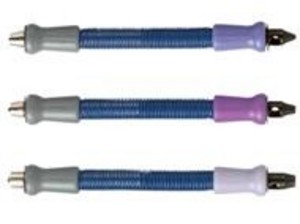While fishing with friends on Utah’s Green River recently, I suffered the fate that all fishermen dread. I impaled myself with a fish hook. I was fishing with a lure armed with two large treble hooks, and, because of a careless maneuver, I buried one prong of the rear treble hook deep in my own hand.
It was day two of a three day raft trip. We were many miles from any medical help, and the hook was lodged firmly in my flesh right up to the shaft. After cutting the lure off the hook near the eyelet, I first tried just pulling it out the same way it went in with fishing pliers. It’s remarkable how resistant skin is to tearing when you apply simple brute force. The barb on the hook held it firmly in place no matter how hard I tried to pull it out. The skin stretched painfully, but the hook stayed put.
I could think of only two other options. One was to force the point of the hook on through until the barbed end emerged through the skin at another point in my hand, then cut the barb off and back it out. The other was to perform minor surgery, cutting my skin open in line with the hook and removing it from a bloody wound. It could have been a small disaster for me, ruining the trip and risking infection and loss of blood. I had seen both of these techniques performed on companions during previous trips, and I didn’t like either one of them. I had even seen one friend undergo the “grip and rip” method, where another fisherman grasps the exposed part of the hook with pliers and then pulls for all he’s worth until the hook simply rips through, leaving an ugly jagged tear in the flesh.
Then, thank goodness, one of my fishing buddies remembered a technique he had read about years earlier in a fishing magazine. It proved to be the best and least painful way I had ever seen or heard about. I got to see it work “first hand,” and I want to share it with you in case you or one of your companions among the 55 million Americans who sport fish each year suffer the same fate.
Unless the hook is embedded in a body part where you can use both of your own hands, this procedure is best performed by someone other than the hooked fisherman. It works with large or small hooks, treble or single, although the first step with a treble hook is to turn it into a single hook by cutting off the two prongs not buried in the victim, as close to the central shaft as possible. This gets them out of the way and prevents them from becoming new threats during the last step. You will need a pair of wire cutters to do this, but you should carry them in your tackle box routinely, and most fisherman’s pliers include a wire cutting feature.
Once you are dealing with a single hook on the shaft, you’re ready for the next steps. Start by cutting a section of fishing line about twenty inches long. If the line is 10 pound test or stronger, one section will be enough. If it is lighter line, double or triple it. You want to be sure the line is strong enough that it doesn’t break during the final step. It is probably best to tie the line into a loop so you don’t lose your grip. You may even want to put a piece of wood through your end of the loop, once you get it positioned, to keep it from slipping from your hand.
To prepare the hook for the dramatic removal, stabilize the hooked body part so that there will be as little movement from the victim as possible. Slip the loop of your fishing line around the shaft of the hook and grip the line with one hand without putting any tension on the shaft of the hook. Here is where you might want to use a stick or other object to form a sort of T handle on the pulling end.
Using the thumb of your other hand, press the shaft of the hook down against the victim’s skin so that part of the bend of the hook is exposed and is curving up from the point of penetration. This may cause some minor pain for the victim, but it won’t last long. You should now have the shaft of the hook held down firmly with one hand and the fishing line in the other, looped around the bend of the hook as close to the skin as possible, with the line held in the opposite direction from the shaft parallel to the skin, and no tension on the line.
The final step is to pull quickly and forcefully on the fishing line straight back as if you are trying to start a gas powered lawnmower. The line will pull the hook out in the exact opposite direction from where it went in, and the hook will pop back out the same hole it entered with minimal trauma to the victim. It will be quick and nearly painless, leaving a hole not much bigger than the original entry wound. In fact, it happens so fast that it almost seems like a magic trick.
A word of caution for the hook Houdini, however. That hook will be traveling fast and looking for fresh meat, so don’t put your own body parts in the direct line of its flight or you could be taking turns performing this little trick.
Of course, use common sense. This method of hook removal is not appropriate if the hook is lodged in a particularly sensitive or delicate area, such as near an eye, in the nose or in some parts of the ear. If in doubt, abandon the trip and seek medical help immediately.
A last word to the victim. After disinfecting the small wound left by this procedure, you’ll be able to fully enjoy the rest of your trip, as I did, but be prepared for your buddies to remind you loudly and often of your biggest catch of the day.








